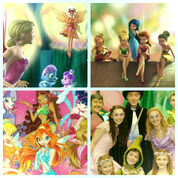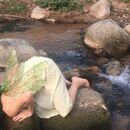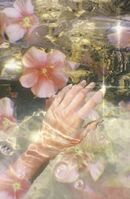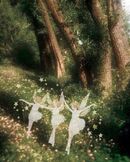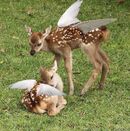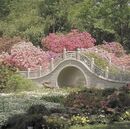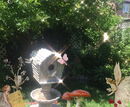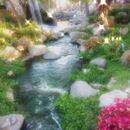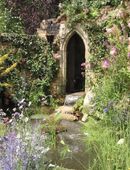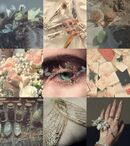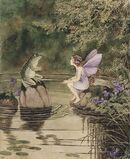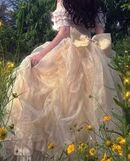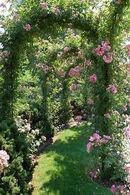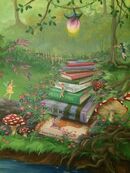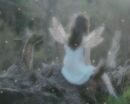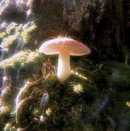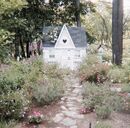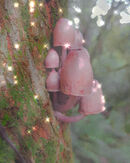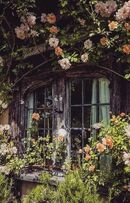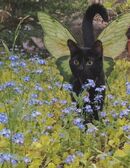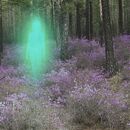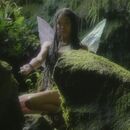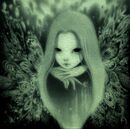Fairycore, also known as Fairy Folk, is a fantasy themed aesthetic that centres predominantly around fairy (alternatively spelled faerie) and elf mythology. Visuals include nature, soft pastels, butterflies, magic, flowers, soft animals like bunnies, and the vibe of springtime. Fairycore usually features feminine visuals and styles, and the more masculine equivalent/subtype is Elfcore( as traditionally, elf is a masculine term and fairy is the feminine term).
Any and all fey-like creatures from mythology around the world are included. This ranges as far and wide as Celtic, Scottish, Nordic, German, French, Native American, Japanese, Chinese, etc. It includes the typical Fae and fairies (usually from Scottish Seelie and Unseelie) as well as various kinds of mermaids, elves, nymphs, shapeshifters (like swan maidens/men), and various ghostly figures.
It is most similar to Cottagecore, Pixiecore, and Goblincore. The term was coined by an unknown Tumblr user. The aesthetic is popular with fairykin, people who incorporate the concept of fairies into their personal identity.
Although it is similar to many nature based aesthetics, some say it is the feminine equivalent to Goblincore. This is debatable, because fairycore focuses on the beauty of nature, such as flowers, fairies, dresses, and femininity, while Goblincore is more based on appreciating the not so pretty parts of nature, like mushrooms, bugs, dirt, etc.
History[]
Since the mid-Victorian period, there has been a fairy fandom. During this time period, countless ballets, operas, books, poems, and an entire sub-genre of artwork (Victorian Fairy Painting) were spawned from this obsession with “Fair Folk” that lasted until World War II.
Yet while the stoic realism of years to come left a hole in the adult side of Fairy for a long time, the rise of fantasy during the 80s brought back the fandom.
Brian and Wendy Froud, Alan Lee, and Charles Vess were artists of massive importance in the scene, particularly for their influence on literature and film. Authors like Terri Windling, Charles de Lint, Emma Bull, Patricia A. McKillip, Diana Wynn Jones, Robin McKinley, Ellen Kushner, Neil Gaiman, and many others revitalized Faerie by taking it into urban environments.
A few key films like Labyrinth, The Dark Crystal, and Legend helped change the view of fairies from tiny pixies into strange and inhuman creatures. Books like War For the Oaks, Jack the Giant-Killer, and Borderland took fairies out of their unknown realms and brought them into 80s era musically-inclined America and Canada, thus pioneering Urban Fantasy and Mythpunk.
This fandom moved into comic books in the 90s thanks to the teaming of Charles Vess and Neil Gaiman in Sandman: A Midsummer Night’s Dream and Stardust.
After a brief lull, the early 2000s brought Faerie back full-force. Faerie Magazine (now Enchanted Living) and Faeriecon brought fans of fairies, mermaid, and other related creatures together. YA writers like Holly Black, Julie Kagawa, Laini Taylor, and Maggie Steifvater, although their work was less literary and more teenage, revitalized the 80s scene for a whole new generation.
Kid's fare like Winx Club, Barbie in Fairytopia, Bratz Fashion Pixiez, and Tinker Bell/Pixie Hollow were mixed in their views of fairy. They either brought back fairies to the tiny Victorian ideals or embraced Urban Fantasy’s view of them as mysterious “Fair Folk” that could walk amongst humanity virtually unseen.
In more recent years, Holly Black, Cassandra Clare, and especially Sarah J. Maas have brought attention to the idea of “The Fae”, influenced by older Scottish and Irish mythologies much as the 80s authors were, only humanizing them.
Yet while this has influenced a massive amount of Fae-centric romance novels, there has been some mild backlash. More and more modern writers (like Erin A. Craig and Joanna Ruth Meyer) have been returning to the idea of Fairy as inhuman and embracing darker, horror-inclined themes.
Visuals[]
Photos used in this aesthetic are often edited to have soft but vibrant colours. A blur and/or sparkle effect is also very common. Small amounts of collaging may be used to paste wings, flowers, mushrooms, etc. onto the photo subject.[1]
It’s important to realize that it is visually multifaceted. Some prefer the pastels, sparkles, and "The Fairies" while others are more into earth-tones, foliage, and "The Fae", and these are equally viable.
Motifs included in this aesthetic:
- The forest
- Trees
- Fields, especially fields of flowers
- Swamps
- Tall, thick grass
- Mushrooms
- Fairy wings
- Traditionally cute or gentle forest animals
- Rivers, streams, and creeks
- Flowers, especially tall flowers
- Nature paths
- Overgrown buildings
- Gardens
- Cozy cabins
- Clotheslines
- Butterflies
- Picnics (baskets, jam jars, tea)
- Throw blankets
- Gingham
- Vines
- Fairy lights
- Cute bugs (bees, butterflies, ladybugs)
Fashion[]
Fairycore fashion is inspired by artistic depictions of fairies, so outfits usually have a Ethereal vibe, with heavy Cottagecore and nature inspiration. Faecore fashion includes:
- Wire-rimmed glasses
- Bows and ribbons
- Lace and sheer fabrics
- Dresses
- Glittery, shimmery, or glowing makeup
- Slippers, open-toe shoes, or sometimes no shoes at all
- Hair worn down or in loose hairstyles such as messy buns and quick/messy braids
- Pastel painted nails or no polish at all, occasionally dirt beneath nails to reference gardening
- Jewelry like long gold necklaces and moonstone/opal rings and bracelets
- Corsets, especially green or white (more popular with people on TikTok who consider themselves fairycore)
- Vests
- Puffy dresses
- Elf ears
- Fairy wings (often DIY)
- High knee socks
- Fingerless gloves
- Platform shoes
- Leg warmers
Décor[]
Fairycore enthusiasts often try to decorate their habitat in line with the chosen aesthetic. Similar to fashion choices, they favour maximalistic approach with lots of knick knacks and rustic vibe[2]. Common décor choices include:
- Collections of crystals, stones, scented candles, dry-preserved butterflies and bugs, and dried herbs.
- House plants, especially vining ones.
- Flower garlands.
- Plant terrariums.
- DIY décor pieces, such as handmade dreamcatchers and windchimes.
- Soft lights and string lights.
In terms of room décor, fairycore often overlaps with witchcore, cottagecore, and goblincore.
Hobbies:[]
Fairies, or people who are fairycore, often have nature-related or crafty hobbies such as:
- Going for walks
- Picking wild berries such as raspberries and blueberries
- Pressing flowers
- Making flower crowns
- Playing harmless pranks on people, such as apple-pie beds, in the case of mischievous fairies
- Scavenging or searching for shiny objects
- Gardening
- Embroidery, sewing, or knitting
- Reading
- Writing
- Drawing
- LARPing and RPG
- Attending Renaissance festivals
- Collecting rocks, seashells, and sticks
- DIY projects, such as making book nooks, wood paintings[3], etc.
Similar Aesthetics[]
Fairycore overlaps significantly with Cottagecore and Goblincore.
Cottagecore[]
Cottagecore is an aesthetic based off of country living, nature, plants, etc. On the TikTok platform, common themes are mushrooms, frogs, and forests, but is still slightly different from Fairycore though it's debatable; some say Cottagecore is the same as Fairycore but without the magic.
Similarities[]
- Old/rustic things
- Animals and forest creatures
- Gardens and plant life
- Picnics
Goblincore[]
Goblincore is a more grungy take on Cottagecore. It's based off of goblins and gremlins, which are fantasy creatures like fairies, but are more dirty and rough.
Similarities[]
- A passion for shiny objects and mischief
- A love for animals of the wild variety
- Gardens because of the dirt and sometimes bugs
- Fantasy/fairytale creatures
Subgenres[]
Dark Fairycore[]
Unlike Strega (closely related to Ethereal Goth), Dark Fairycore has no connection to the Goth genre of music. Like Fairycore, it's mainly a literary and artistic movement throughout the many facets of the fantasy genre. However, it is similar in its imagery and content.
Dark Fairycore typically encompasses the visual works of Brian and Wendy Froud, as well as the Victorian artist John Anster Fitzgerald. Books would include much of urban fantasy aka Mythpunk, particularly the works of Neil Gaiman and other 80s to 90s authors in the genre.
If Fairycore is Seelie, Dark Fairycore is Unseelie. If Fairycore is represented by Tinker Bell, Dark Fairycore is better displayed by Maleficent. Typically, the fairies of Dark Fairycore are human-sized instead of tiny. They are inhuman, a bit more antagonistic, and typically referred to as Fae.
Their imagery is darker, stranger, and moodier, like deep forests after rain or a tangle of thorns surrounding a single rose.
Mermaidcore[]
- See also: Mermaid
Under Construction
Elfcore[]
Under Construction
Media[]
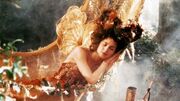
A Midsummer Night's Dream (1999)
Literature[]
- The Faerie Handbook by Carolyn Turgeon
- The Mermaid Handbook by Carolyn Turgeon
- The Unicorn Handbook by Carolyn Turgeon
- The King of Elfland’s Daughter by Lord Dunsay
- Peter and Wendy by J. M. Barrie
- Smith of Woonton Major by J. R. R. Tolkien
- Fire and Hemlock by Diana Wynn Jones
- Jack the Giant-Killer by Charles de Lint
- Fairy Oak series by Elisabetta Gnone
- War For the Oaks by Emma Bull
- The Changeling Sea by Patricia A. McKillip
- Spindle's End by Robin McKinley
- Stardust by Neil Gaiman
- Changeling by Delia Sherman
- Maleficent: Heart of the Moors by Holly Black
- Wondrous Strange trilogy by Lesley Livingston
- Faery Rebels series by R. J. Anderson
- Married to Magic series by Elise Kova
- The Faery Reel: Tales from the Twilight Realm edited by Ellen Datlow and Terri Windling
- Bohemian Manifesto: A Field Guide to Living On the Edge by Lauren Stover (features a guide to Fairy Folk)
- The Land of Stories by Chris Colfer
- A Tale of Magic… by Chris Colfer
- The Complete Fairy Tales by George MacDonald
- Rainbow Magic series by Daisy Meadows
Film[]
- Sleeping Beauty (1959)
- Ridley Scott’s Legend (1985)
- The Dark Crystal (1982)

An example moodboard, featuring children's media that utilises the fairycore aesthetic. Includes Barbie Fairytopia: Magic Of The Rainbow (2007), Tinker Bell (2008), Winx Club (2004) and The Fairies (2005).
- Ridley Scott’s Legend (1985)
- Labyrinth (1986)
- Rumpelstiltskin (1987)
- Ferngully: The Last Rainforest (1992)
- Thumbelina (1994)
- FairyTale: A True Story (1997)
- A Midsummer Night's Dream (1999)
- The Lord of the Rings film trilogy (2001-2003)
- Barbie of Swan Lake (2003)
- Barbie in Fairytopia (2005)
- Stardust (2007)
- Enchanted (2007)
- Tinker Bell (2008-2014)
- Maleficent (2014)
- Rainbow Magic: Return to Rainspell Island (2010)
Television[]
- Shelley Duvall’s Faerie Tale Theater (1982-1987)
- The Rebirth of Mothra (1996-1998)
- Winx Club (2004-2019)
- Once Upon A Time (2011-2018)
- Rilu Rilu Fairilu (2016-2019)
Video Games[]
- Dungeons and Dragons
- Blue Rose: An ACE Roleplaying Game
- Changeling: The Dreaming
- Il Mheg in Final Fantasy XIV
- Odin Sphere (Playable fairy character and fairy themes)
Music[]
There is no specific Fairycore music, as it is mostly a literary and artistic genre. Regardless, folk music particularly has a long history of chronicling fairy ballads of Ireland and Scotland, as does the work of Celtic singers.
Artists[]
- Enya
- Celtic Woman
- Chinatsu Kuzuu
- Bel Canto
- Cocteau Twins
- Virginia Astley
- Hexperos
- Caprice
- Fleur
- Donovan
- Stevie Nicks
- Erutan
- Melanie Martinez (2023, Portals era)
- Emilie Autumn
- Zheani
- Emma Harvey (Yungelita or Elita Harkov)
- Rachel Rose Mitchell
- Rigël Theatre
- FAUN
Albums[]
- Victorialand by Cocteau Twins
- Amarantine by Enya
- Songs of Innocence and Experience by Caprice
- Ancient Land by Celtic Woman
- PORTALS by Melanie Martinez
Songs[]
- Fairy Tale by Joey Pecoraro
- The Willow Maid by Erutan
- For the Dancing and the Dreaming by Erutan
- My Fairy King by Queen
- The Fairy Fellow’s Master Stroke by Queen
- Follow Me by Celtic Woman
- Fairytale by Kalafina
- Oblivious by Kalafina
- FAERIE SOIRÉE by Melanie Martinez
- SPIDER WEB by Melanie Martinez
- LEECHES by Melanie Martinez
- NYMPHOLOGY by Melanie Martinez
- POWDER by Melanie Martinez
- She Bangs Like A Fairy On Acid by Elita Harkov
- Lurie by Rigël Theatre
Resources[]
External links to help get a better understanding of this aesthetic.
- Enchanted Living Magazine
- Reddit subs such as /fairy and /fairycore_world
Vendors[]
- Birdwithcowboyhat
- The Cottagecore
- Linennaive
- Selkie
- Lirika Matoshi
- DÔEN
- Lurelly
- Pellucid
- CostureroReal
- Fairycore | Etsy
- Fairycore Clothes
Playlists[]
- fairycore
- cottagecore/fairycore 🍄🧚♀️🐈 Spotify playlist by hikikomori harlow
- fairycore ✨ Spotify playlist by kailey<3
- fairycore 🍄🧚 by faun the deer
- tea party with faeries but instead of tea it's peach soju by jessie
- fairycore🧚🌸🍄 by blanca
- fairycore Spotify playlist by emaki
- Fairycore 🌼🍄🌿 Spotify playlist by Keri Aldana
- looking for fairies. by miraya ☁️
Pinterest Boards[]
- aesthetics // fairycore by gracelynn
- Fairies
- ꒰ fairycore ꒱ by yongiez
- fairycore aesthetic by kyley madison
- –fairycore by °❀𝔸𝕝𝕝𝕪𝔹𝕖𝕝𝕝𝕖❀°
- fairycore × fairy grunge × pixiecore by angelsarewatching56

